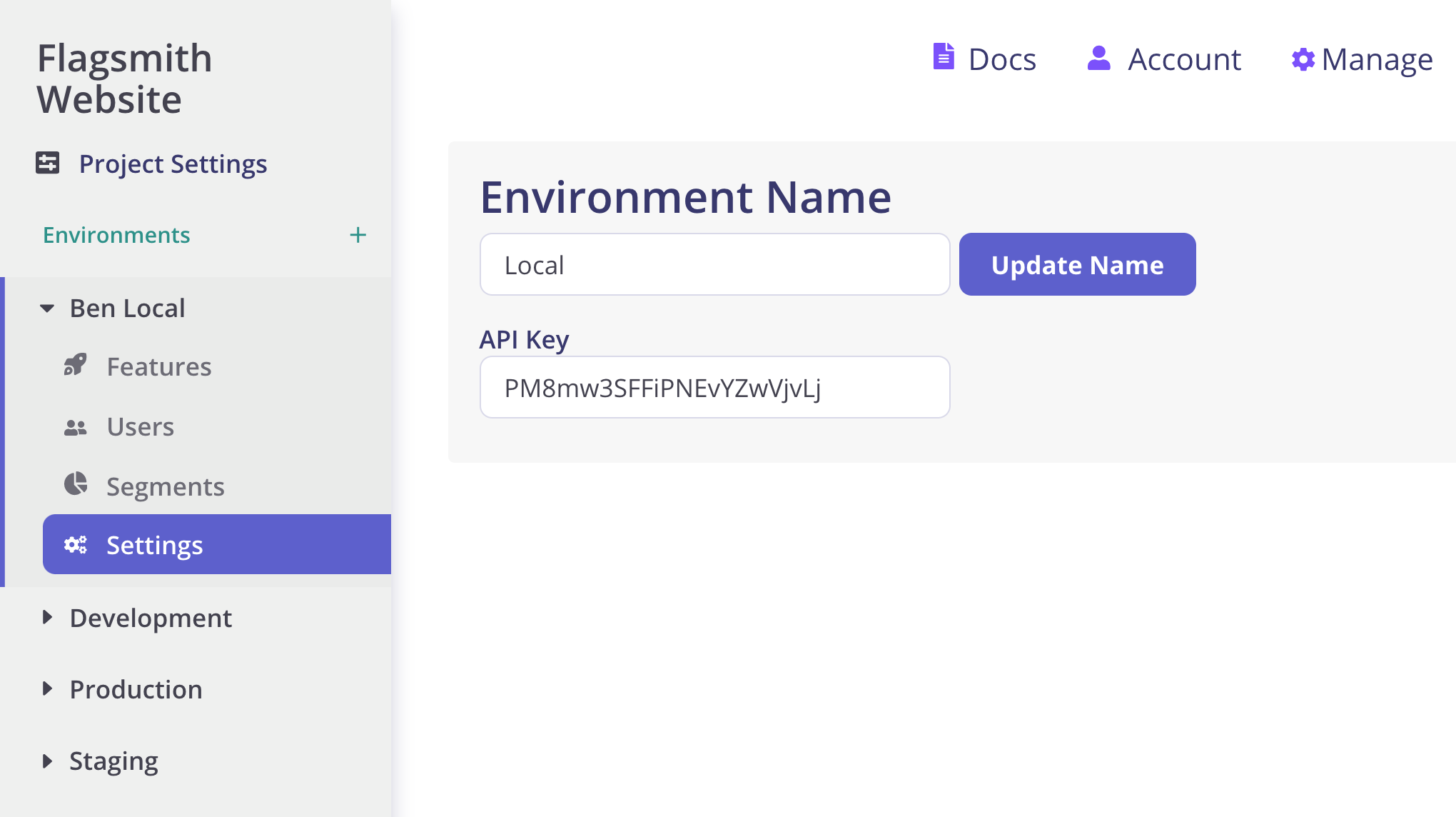Flagsmith Flutter SDK
This SDK can be used for Flutter applications. The source code for the client is available on Github.
The Flagsmith Flutter SDK supports iOS, Android and Web targets.
Getting Started
The client library is available from the https://pub.dev/packages/flagsmith:
dependencies:
flagsmith:
Basic Usage
The SDK is initialised against a single environment within a project on https://flagsmith.com, for example the Development or Production environment. You can find your environment key in the Environment settings page.

Retrieving feature flags for your project
Sign Up and create an account at https://flagsmith.com/
In your application, initialise the Flagsmith client with your API key:
import 'package:flagsmith/flagsmith.dart';
final flagsmithClient = FlagsmithClient(
apiKey: 'YOUR_ENV_API_KEY'
config: config,
seeds: <Flag>[
Flag.seed('feature', enabled: true),
],
);
await flagsmithClient.initialize();
await flagsmithClient.getFeatureFlags(reload: true) // fetch updates from api
if you prefer async initialization then you should use
import 'package:flagsmith/flagsmith.dart';
final flagsmithClient = await FlagsmithClient.init(
apiKey: 'YOUR_ENV_API_KEY',
config: config,
seeds: <Flag>[
Flag.seed('feature', enabled: true),
],
);
await flagsmithClient.getFeatureFlags(reload: true) // fetch updates from api
To check if a feature flag exists:
bool featureExists = await flagsmithClient.hasFeatureFlag("my_test_feature");
Check if Feature flag exist and is enabled:
bool featureEnabled = await flagsmithClient.isFeatureFlagEnabled("my_test_feature");
if (featureEnabled) {
// run the code to execute enabled feature
} else {
// run the code if feature switched off
}
To get the configuration value for a feature flag:
final myRemoteConfig = await flagsmithClient.getFeatureFlagValue("my_test_feature");
if (myRemoteConfig != null) {
// run the code to use remote config value
} else {
// run the code without remote config
}
To listen for fetch request state
flagsmithClient.loading.listen((state){
// FlagsmithLoading.loading
// FlagsmithLoading.loaded
});
To listen for feature flag changes:
flagsmithClient.stream("my_test_feature").listen((value){
// call to action
});
StreamBuilder(
stream: flagsmithClient.stream("my_test_feature"),
builder: (context, AsyncSnapshot<String> snapshot) {
if (snapshot.connectionState == ConnectionState.waiting) {
return CircularProgressIndicator();
}
return TextButton(
onPressed: snapshot.data.enabled ? (){} : null,
child: Text('Call to Action'),);
},
),
Cached flags
You can use caches instead of async/await
final config = FlagsmithConfig(
baseURI: 'http://yoururl.com/',
connectTimeout: 200,
receiveTimeout: 500,
sendTimeout: 500,
storeType = StoreType.inMemory,
caches: true, // mandatory if you want to use caches
);
await flagsmithClient.initialize();
final flagsmithClient = await FlagsmithClient.init(
apiKey: 'YOUR_ENV_API_KEY',
config: config,
seeds: <Flag>[
Flag.seed('feature', enabled: true),
],
);
await flagsmithClient.getFeatureFlags(reload: true); // fetch updates from api
bool isFeatureEnabled = flagsmithClient.hasCachedFeatureFlag('feature');
Identifying users
Identifying users allows you to target specific users from the Flagsmith dashboard.
To check if a feature exists for a given user Identity:
final user = Identity(identifier: 'flagsmith_sample_user');
bool featureEnabled = await flagsmithClient.hasFeatureFlag('my_test_feature', user: user);
if (featureEnabled) {
// run the code to execute enabled feature for given user
} else {
// run the code when feature switched off
}
To get the configuration value for a feature flag for given a user Identity:
final myRemoteConfig = await flagsmithClient.getFeatureFlagValue('my_test_feature', user: user);
if (myRemoteConfig != null) {
// run the code to use remote config value
} else {
// run the code without remote config
}
To get the user traits for given user Identity:
final userTraits = await flagsmithClient.getTraits(user)
if (userTraits != null && userTraits) {
// run the code to use user traits
} else {
// run the code without user traits
}
To get user trait for given user Identity and specific Trait key:
final userTrait = await flagsmithClient.getTrait(user, 'cookies_key');
if (userTrait != null) {
// run the code to use user trait
} else {
// run the code without user trait
}
Or get user traits for given user Identity and specific Trait keys:
final userTraits = await flagsmithClient.getTraits(user, keys: ['cookies_key', 'other_trait']);
if (userTraits != null) {
// run the code to use user traits
} else {
// run the code without user traits
}
To update a user trait for given user Identity:
final userTrait = await flagsmithClient.getTrait(user, 'cookies_key');
if (userTrait != null) {
// update value for user trait
var updatedTrait = userTrait.copyWith(value: 'new value');
Trait updated = await flagsmithClient.updateTrait(user, updatedTrait);
} else {
// run the code without user trait
}
Reset storage
To reset storage and re-seed default values
await flagsmithClient.reset();
Override default configuration
By default, the client uses the default configuration. You can override this configuration as follows:
final flagsmithClient = FlagsmithClient(
config: FlagsmithConfig(
baseURI: 'http://yoururl.com/'
), apiKey: 'YOUR_ENV_API_KEY');
Override the default configuration with your own:
final flagsmithClient = FlagsmithClient(
config: FlagsmithConfig(
baseURI: 'http://yoururl.com/',
connectTimeout: 200,
receiveTimeout: 500,
sendTimeout: 500,
storeType = StoreType.inMemory,
caches: true,
), apiKey: 'YOUR_ENV_API_KEY');
Known issues
- If using the package Dio, you may encounter an error saying
Bad state: Future already completed. There is a bug in the Dio package, introduced in 4.0.5 (and as of writing this on 12/09/2022, is unresolved). To resolve, you'll need to pin your Dio version in pubspec.yaml to 4.0.4 or earlier. You can track the state of this issue here within our repo and also at the dio repo.